线程池剖析
一、前置问题
- 线程的状态转换
为什么要使用线程池
线程池的继承体系
线程池使用的场景
线程数的设置规则
线程池的状态转换
线程池的关键参数
线程池的接收任务后的执行流程
线程池的异常处理
submit和exec的区别
线程池的拒绝策略
二、进程和线程
进程是分配资源的最小单位,进程间资源隔离
线程是CPU调度的最小单位
一个进程往往包含多个线程,多个线程在进程内可共享进程的资源
多线程可简化编程,把涉及并发和多步的问题域映射为多线程;
三、线程的状态
通过java.lang.Thread#getState方法可以获取当前线程状态,其用枚举标识。
1 | /** |
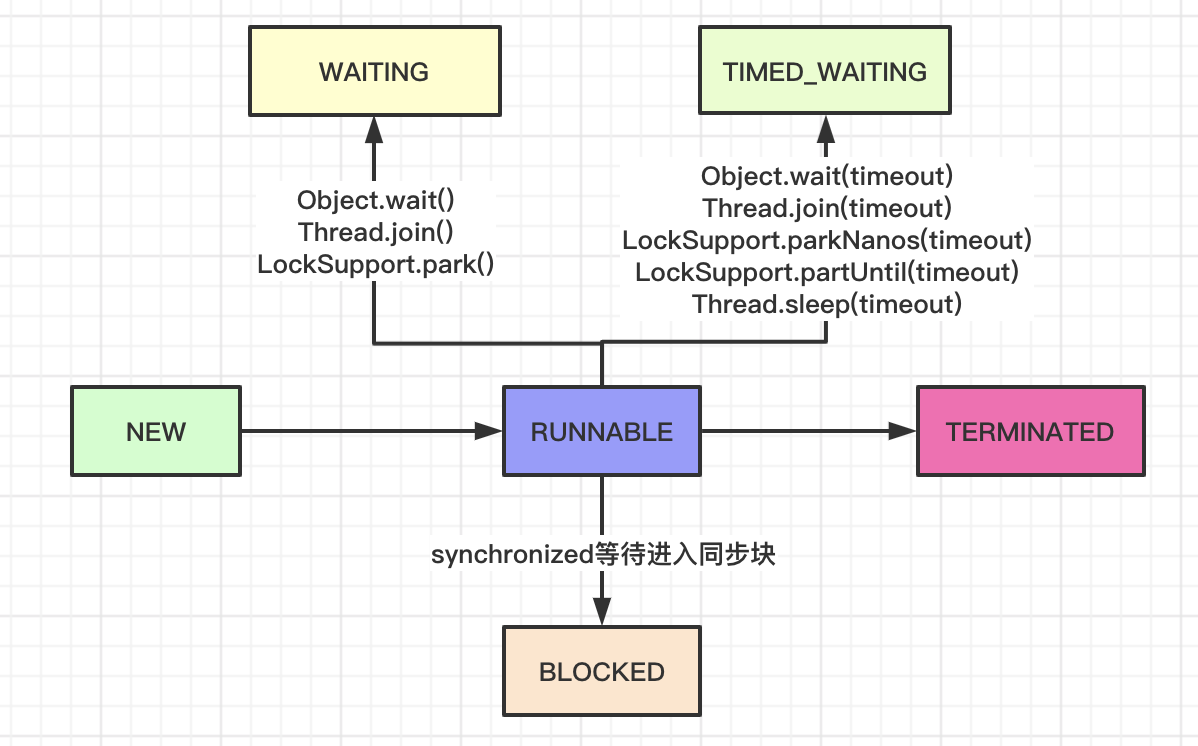
四、线程池
1、为什么使用线程池
减少线程创建和销毁的开销
提高响应速度,因为去掉了线程创建的时间
更好的管控线程,例如控制线程创建数,避免线程创建过多导致资源耗尽
2、使用场景
使用线程池处理的任务不能有依赖关系,否则会导致并发度下降,甚至会有死锁发生;
常用于处理执行时间较短,但又数量大的任务;
3、继承体系
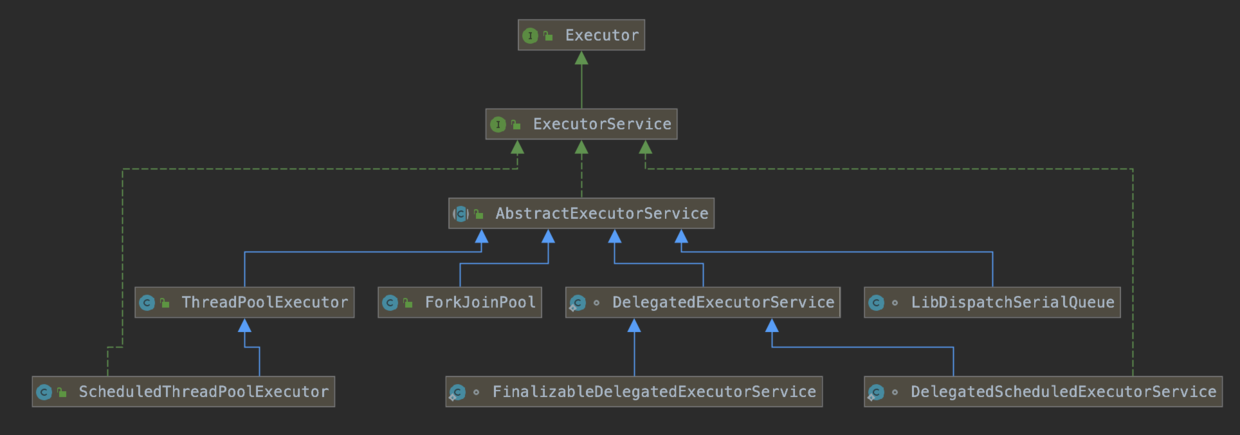
4、线程池的状态
1 | /** |
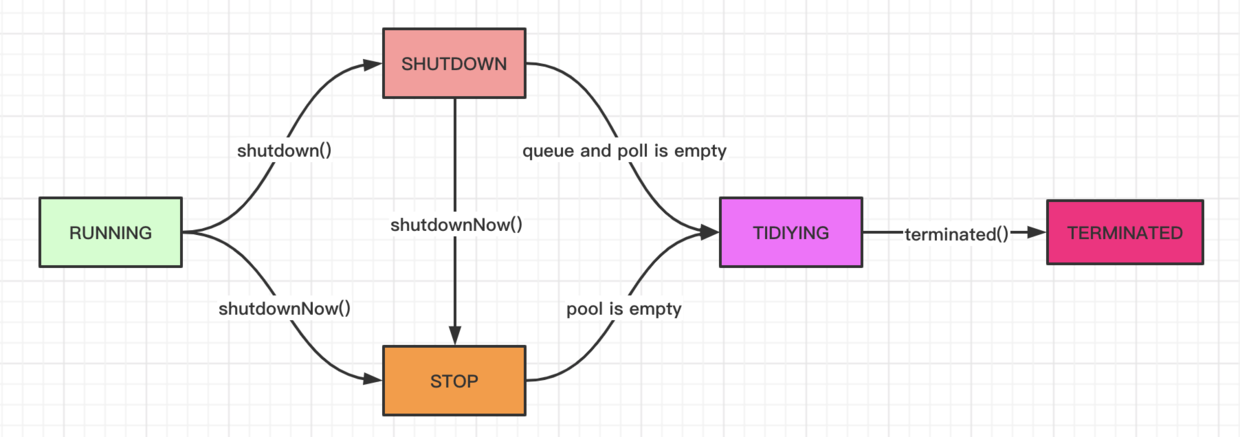
5、线程池数量
线程数量 = ((线程等待时间 + 线程CPU时间) / 线程CPU时间) * CPU个数
五、ThreadPoolExecutor
1、初始化参数
1 | /** |
1)corePoolSize:线程池核心线程数,即使空闲也不会结束;
2)maximumPoolSize:线程池可创建的最大线程数
3)keepAliveTime:非核心线程等待任务的最大时间,超过该时间线程会终止
4)unit:时间单位
5)workQueue:存放任务的阻塞队列
6)threadFactory:线程工厂,可用于定制线程的名称和异常处理等;
7)handler:线程池的饱和策略,当阻塞队列放满且线程达到最大值时,新提交的任务会通过具体的饱和策略进行处理。
- AbortPolicy:默认策略,抛出RejectedExecutionException异常;
- DiscardPolicy: 忽略,不执行任何逻辑;
- DiscardOldestPolicy: 抛弃旧的任务,然后再次提交任务
- CallerRunsPolicy: 提交任务的线程执行任务

2、提交任务:submit和execute区别
1)submit会调用newTaskFor方法封装任务为FutureTask,然后调用execute,返回FutureTask。
1 | public class FutureTask<V> implements RunnableFuture<V> { |
FutureTask执行时会catch任务执行的异常,调用Future.get方法时会抛出异常;
2)execute没有返回值,不会包装runnable为FutureTask,Woker执行异常时会导致Worker线程结束。
3、原理
当通过sumite或execute提交一个任务时,有以下3个场景:
1)如果线程池的线程数小于corePoolSize
新建核心线程,并把提交的任务作为该线程处理的第一个任务;
2)如果线程池的线程数不小于corePoolSize
把任务加入阻塞队列;
3)如果加入阻塞队列失败
新建非核心线程,并把提交的任务作为该线程处理的第一个任务;
4)如果核心线程池已到达最大值
执行跑和策略

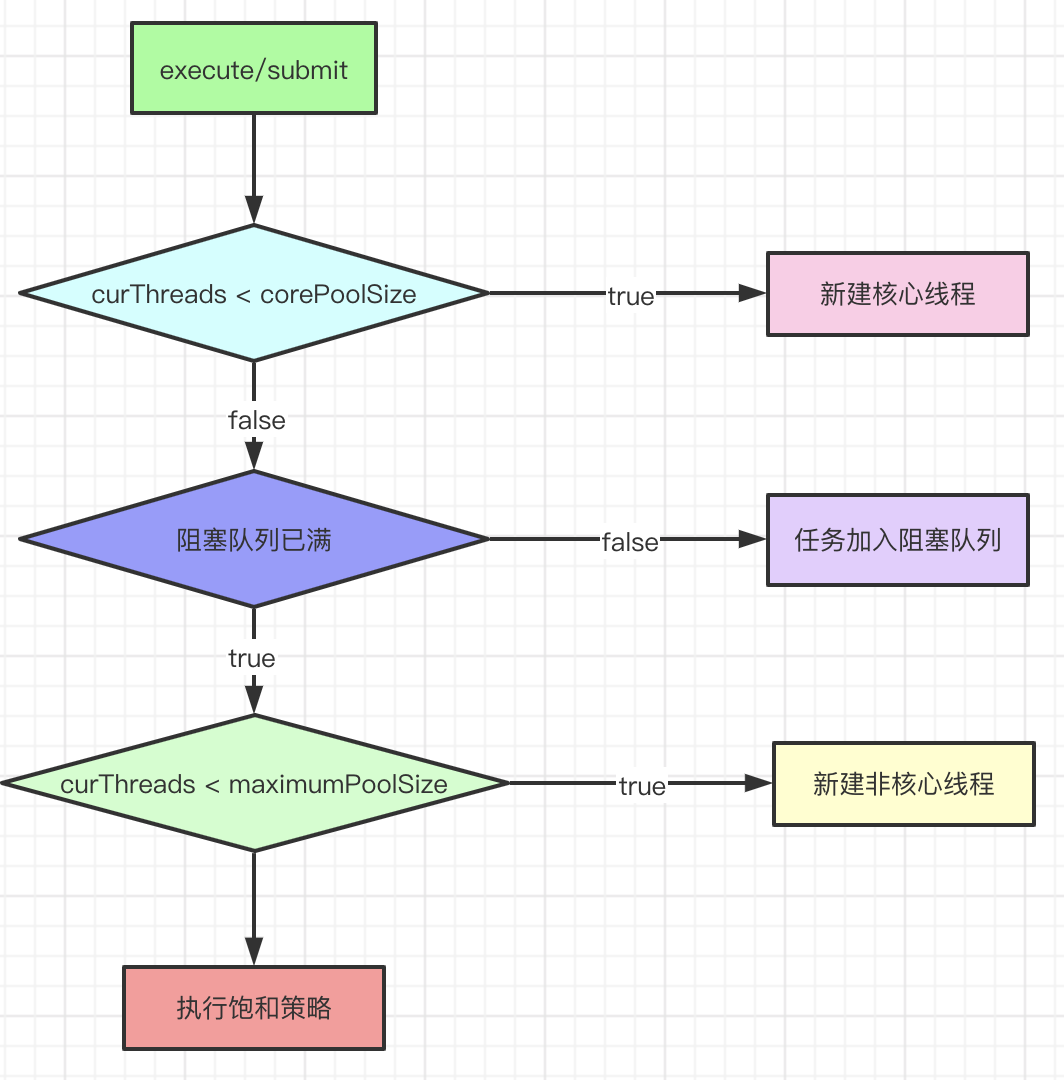
4、线程池关闭
1)shutdown:调用后会设置线程池状态为SHUTDOWN,不再接受新任务,新任务会执行拒绝策略,阻塞队列里已有任务仍会处理。
2)shutdownNow:调用后会设置线程中断标志,设置线程池状态为STOP。然后会移除阻塞队列里的任务。getTask时发现处于STOP时,会减少worker数,然后返回null。
5、异常处理
1)线程中断异常:woker会退出,但是退出前在runworker方法中finally块会执行worker-1操作。
2)任务执行异常:提交的任务被封装为FutureTask,里面捕获了所有异常,不会导致woker退出。
所以即使设置了setUncaughtExceptionHandler,也会感知不到任务失败。所以还是在任务中增加try-catch最好。
六、ScheduledThreadPoolExecutor
1、前置问题
I、类继承层级
II、使用场景
III、执行原理
IV、任务执行时间超出period或delay后的处理逻辑
V、DelayedWorkQueue实现原理
VI、ScheduledThreadPoolExecutor和Timer的区别
VII、scheduleAtFixedRate和scheduleWithFixedDelay的区别
2、类继承层级
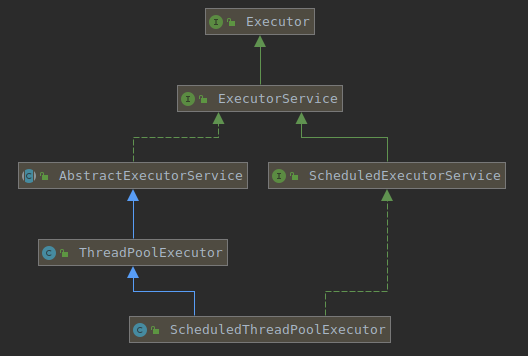
3、使用场景
I、服务注册发送心跳
II、定时拉取FTP文件
III、EDI里定时执行git pull,同步git仓库
IV、分布式锁
4、初始化参数
1 | public ScheduledThreadPoolExecutor(int corePoolSize, ThreadFactory threadFactory, RejectedExecutionHandler handler) { |
1)corePoolSize:线程池核心线程数;
2)threadFactory:线程工厂,可用于定制线程的名称和异常处理等;
3)handler:线程池的饱和策略,当阻塞队列放满且线程达到最大值时,新提交的任务会通过具体的饱和策略进行处理。
- AbortPolicy:默认策略,抛出RejectedExecutionException异常;
- DiscardPolicy: 忽略,不执行任何逻辑;
- DiscardOldestPolicy: 抛弃旧的任务,然后再次提交任务
- CallerRunsPolicy: 提交任务的线程执行任务
5、整体执行流程
I、把任务封装为ScheduledFutureTask
II、把任务加入优先级队列,任务会在队列内排序
III、若线程数小于核心线程,则增加线程
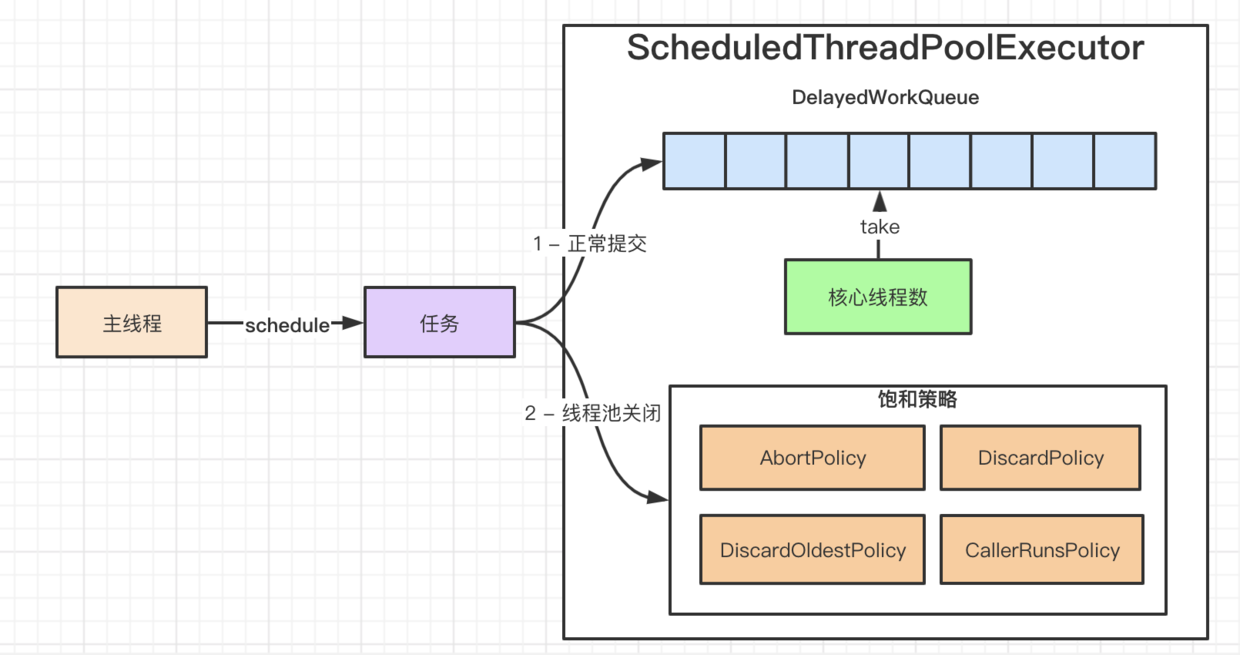
6、提交任务过程
1)4个提交任务方法
1 | // 添加延迟任务 |
2)提交过程
I、把任务封装为:ScheduledFutureTask,包含任务的执行时间、序列号、执行间隔,用于优先级队列排序。
ScheduledFutureTask会捕获所有异常并设置失败标志位,防止Worker线程退出。
II、添加任务到DelayedWorkQueue,一个阻塞的优先级队列。队列使用ReentrantLock的条件队列,防止竞争。
III、调用ensurePrestart,若当前woker小于core,则新增一个worker。
7、队列取任务过程
java.util.concurrent.ScheduledThreadPoolExecutor.DelayedWorkQueue#take
1)通过reentrantLock加锁,进入以下循环逻辑
==循环体开始==
2)队列为空时,available.await() 进入lock的条件队列等待,让出锁。
3)队列非空时
- 首个任务到执行时间:取出任务
- 首个任务不到执行时间:
- leader不为空,
available.await()进入lock的条件队列等待,让出锁。 - leader为空,设置自身为leader,
available.awaitNanos(delay)进入lock的条件队列等待超时,等待结束后,设置leader为null。
- leader不为空,
==循环体结束==
4)leader为空时,且队列非空时,唤醒条件队列
5)unlock
NOTE:queue中的leader超时等待(TIMED_WATING)阻塞队列中的第一个任务,其他woker则等待(WATING)被leader唤醒。
8、任务取消和异常处理
1 | ScheduledThreadPoolExecutor$ScheduledFutureTask |
1)调用FutureTask#cancel方法,会把任务标示为取消态;然后在ScheduledFutureTask#run中调用runAndReset时会判断状态,如果不是NEW则直接返回false;于是会忽略执行逻辑和再次把任务添加到任务队列的逻辑;
NOTE:可以设置setRemoveOnCancelPolicy为true,直接在cancel时把任务从队列中移除,而不用等到任务执行,这可以避免有的任务的延迟很长,短时间内执行不到,占用队列的空间;
2)任务异常时,runAndRest会返回false,于是会忽略把任务添加到任务队列的逻辑;
9、下次执行时间计算
1)schedule方法:非间隔任务
2)scheduleAtFixedRate方法:本次执行时间 + 间隔
3)scheduleWithFixedDelay方法:本次结束时间 + 间隔
NOTE:period的符号区分fixRate(正)和FixDelay(负)。
10、Timer对比
1)线程
- timer为单线程,某任务执行时间长会影响其他任务。
- ScheduledThreadPoolExecutor为线程池任务不会相互影响。
2)执行时间
- timer使用操作系统时间,一旦操作系统时间改变,影响调度
- ScheduledThreadPoolExecutor使用相对时间,不受操作系统时间影响
3)异常处理
- timer不会捕获异常,一旦任务跑出异常,则调度线程也会终止,其他任务不会再执行
- ScheduledThreadPoolExecutor,捕获异常,会保证线程数
4)任务优先级
- timer按系统时间执行,系统时间重置时会有影响
- ScheduledThreadPoolExecutor基于相对时间,且支持排序,DelayedWorkQueue内有优先级队列
11、源码
1)ScheduledFutureTask
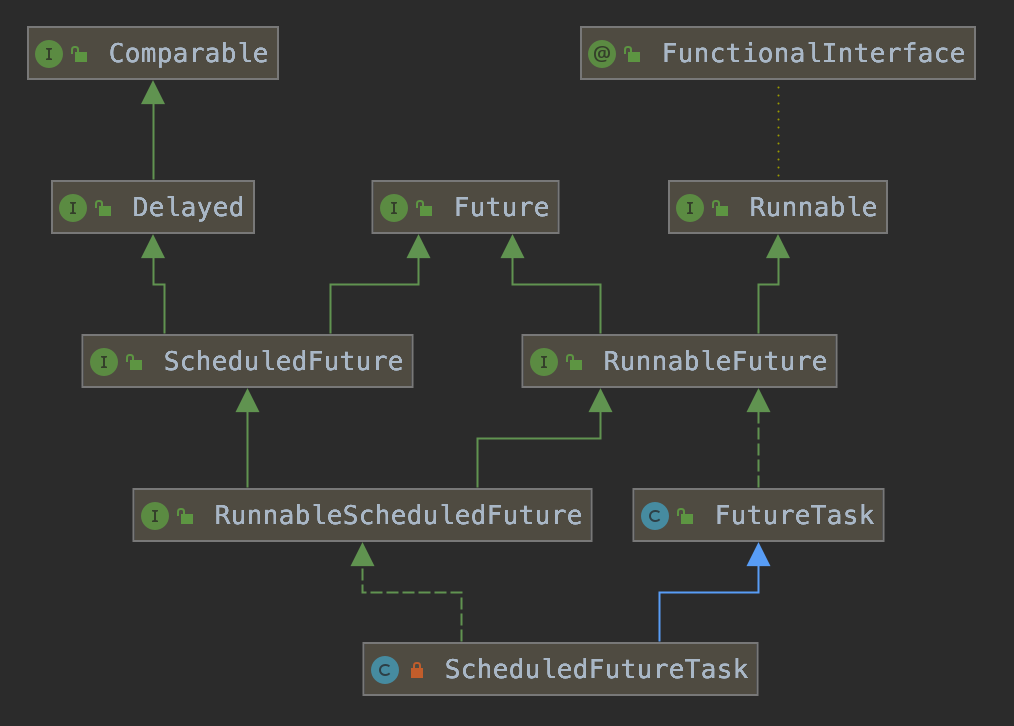
I、关键属性
- time:任务触发的时间
- period:任务执行的间隔,如果是fixRate,则是正数;如果是fixDelay,则是负数;
- sequenceNumber:序列号,为任务的提交顺序
II、实现比较接口,为任务插入优先级队列排序提供支持
- 先按time排序;
- 若time相同,再按Sequence排序;
1 | public int compareTo(Delayed other) { |
III、任务执行后,重置下次的执行时间;并发任务再次插入优先级队列;
- 如果是fixRate,则下次执行时间是
本次执行时间 + 时间间隔 - 如果是fixDelay,则下次执行时间是
当前时间 + 时间间隔
1 | private void setNextRunTime() { |
2)DelayedWorkQueue
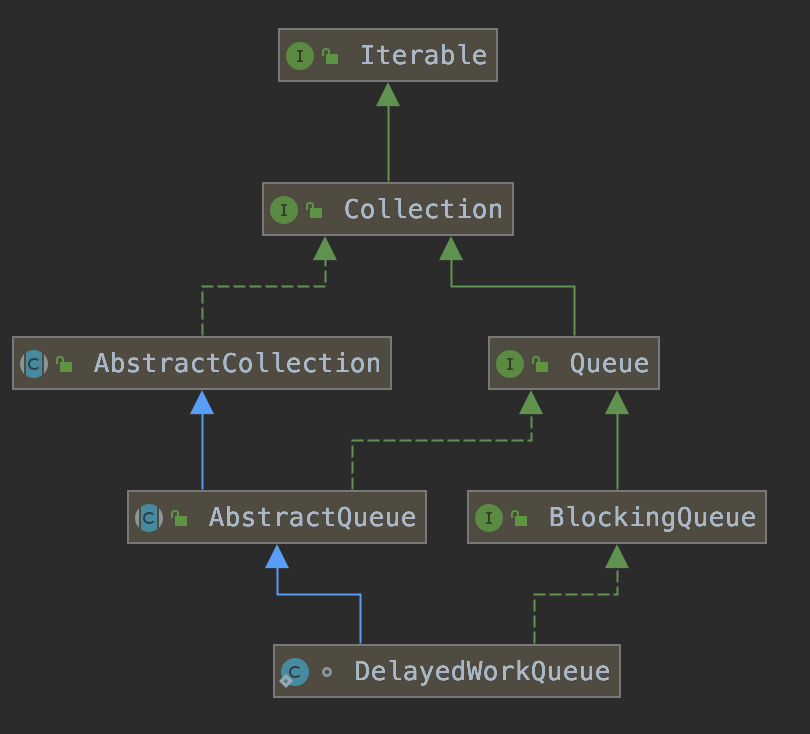
I、内含一个无界的PriorityQueue - 小顶堆实现
II、为减少不必要的定时等待,其实现了一个主从模式变体的等待模型。
1 | static class DelayedWorkQueue extends AbstractQueue<Runnable> |